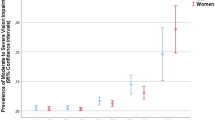Abstract
The authors studied 1,681 consecutive patients who attended their ophthalmic outpatient clinics over a period of 12 months to determine the patients' visual acuity status and the causes of any visual loss. Using the World Health Organization criteria for definition of visual acuity status, 1004 (59.7%) patients had normal vision. Four hundred and thirty-one (25.6%) patients had low vision or visual impairment and 246 (14.6%) patients were blind. Twenty-eight (1.9%) patients had no light perception in both eyes. Cataract, both in isolation and co-existing with other ocular pathology, was the major cause of both low vision and blindness (58.5% and 81.7%, respectively). A concerted attack on cataract alone will markedly reduce blindness and low vision in this region.
Similar content being viewed by others
References
WHO guideline for programmes for prevention of blindness. Geneva: World Health Organisation, 1979.
Dawson CR, Jones BR, Tarizzo ML. Guide to trachoma control. Geneva: World Health Organisation, 1981; pp 38–47.
WHO Expert Committee on Onchocerchiasis. Third report, Geneva' World Health Organisation, 1987; pp 1–67. WHO technical report series 752.
Tielsch JM, Sommer A. The epidemiology of vitamin A deficiency and xerophthalmia. Annu Rev Nutr 1984; 4: 183.
Kupfer CA. A decade of progress in the prevention of blindness. In: Kupfer C (ed) World Blindness and Its Prevention, vol 3. Oxford: Oxford University Press, 1988: 8–14.
Duke-Elder S, Leigh AG. System of ophthalmology, vol III: diseases of the outer eye. St. Louis 1965, Mosby-Year Book, Inc.
Potter AR. Causes of blindness and visual handicap in the Central African Republic. Br J Ophthalmol 1991; 75: 326–8.
Hoyt CS. Vitamin metabolism and therapy in ophthalmology. Surv Ophthalmol 1979; 24 (3): 177.
Tabbara KF, Ross Degnan D. Blindness in Saudi Arabia. JAMA 1986; 255: 3378–84.
Courtney P. The National Cataract Surgery Survey: 1. Method and Descriptive Features. Eye 1992; 6: 487–92.
Johnson GJ, Minassian D, Franken S. Alterations of the anterior lens capsule associated with climatic keratopathy. Br J Ophthalmol 1989; 73: 229–34.
Resnikoff S, Filliard G, Dell' Aquilla B. Climatic droplet keratopathy, exfoliation syndrome and cataract. Br J Ophthalmol 1991; 75: 734–6.
Author information
Authors and Affiliations
Rights and permissions
About this article
Cite this article
Faran, M.F.A., Ibechukwu, B.I. Causes of low vision and blindness in south western Saudi Arabia. Int Ophthalmol 17, 243–247 (1993). https://doi.org/10.1007/BF01007790
Received:
Accepted:
Issue Date:
DOI: https://doi.org/10.1007/BF01007790




